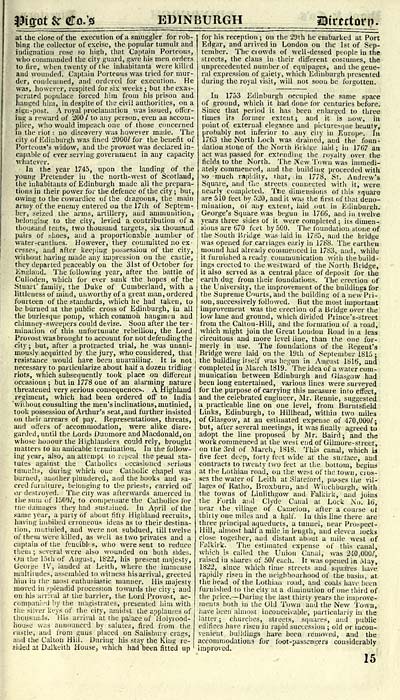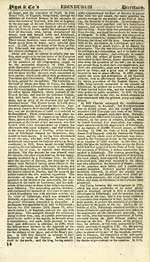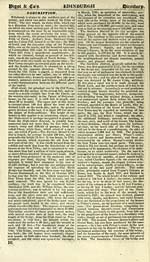Download files
Complete book:
Individual page:
Thumbnail gallery: Grid view | List view

^$iQ(it k Co.'s
EDINBURGH
iBuectoni.
at the dose of the execution of a smuggler for rob-
bing the collector of excise, the popular tumult and
indignation rose so high, that Captain Porteous,
who commanded the city guard, gave liis men orders
to fire, when twenty of tke inhabitants were killtd
and wounded. Captain Porteous was tried for mur-
der, condemned, and ordered for execution. He
was, however, respited for six weelis ; but the exas-
perated populace forced him from his pri.son and
hanged him, in despite of the civil authorities, on a
sign -post. A royal proclamation was issued, offer-
ing a reward of 200 / to any person, even an accom-
plice, who would impeach one of those concerned
in the riot : no discovery was however made. The
city of Edinburj^li was tined 2000/ for the benefit of
Porteou!!'s widow, and the provost was declared in-
capable of ever serving governmeut in any capacity
whatever.
In the year 1745, upon the lauding of the
young Pretender in the north-west of Scotland,
the inhabitants of Edinburgh made all the prepara-
tions in their power for the defence of the city; but,
owing to the cowardice of the dragoons, the main
army of the enemy entered on the 17th of Septem-
ber, seized the arms, artillery, and ammunition,
belonging to the cily, levied a contribution of a
thousand tents, two thousand tai'gets, six thousnnd
pairs of shoes, and a proportionable number of
water-cantines. However, they committed no ex-
cesses, and after keeping po^;sessiou of the city,
without having made any impression on the castie,
they departed peaceably on the 31st of October for
England. The following year, after the battle of
Culloden, which for ever sunk the hopes of the
Stuart' family, the Duke of Cumberland, with a
littleness of mind, unworthy of a great man, ordered
fourteen of the standards, which he had taken, to
be burned at the public cross of Edinburgh, in all
the burlesque pomp, which common hangmen and
cl]imney-svveej)ers could devise. Soon after the ter-
mination of this unfortunate rebellion, the Lord
Provost was brought to account for not defending the
city ; but, after a protracted trial, he was unani-
mously acquitted by the jury, who considered, that
resistance would hare been unavailing. It is not
necessary to paiticularize about half a dozen trifling
riots, which subsequently took place on difl'erent
occasions; but in 1778 one of an alarming nature
threatened very serious consequences. A Highland
regiment, which had been ordered off to India
'v/ithout consulting the men's inclinations, mutinied,
took possession of Arthur's seat, and further insisted
on their arrears of pay. Representations, threats,
and offers of accommodation, were alike disre-
garded, until the Lords Dunmore andMacdonald, on
whose honour the Highlanders could rely, brought
matters to an amicable termination. In the follow-
ing year, also, an attempt to repeal the penal sta-
tutes against the Catholics occasioned serious
tumults, during which one Catliolic chapel was
burned, another plundered, and the books and sa-
cred fiunilure, belonging to tlie priests, carried olf
i)r destroyed. The cily was afterwards amerced in
the sum of 1500/, to compensate the Catholics for
me damages they had sustained. In April of the
same year, a parly of about fifty Highland recruits,
having imbibed erroneous ideas as to their destina-
tion, mutinied, and were not subdued, till twelve
of them were killed, as well as two privates and a
captain of the feneibh s, who were sent to reduce
tijeni ; several were also wounded on both sides.
On the 15th of August, 1822, his present majesty,
George IV, landed at Leith, where the imtiiense
multitudes, assembled to witness his arrival, greeted
hiui in the most enthusiastic manner. His majesty
moved in splendid procession towards the city ; and
on his arrival at the barrier, the Lord Provost, ac-
companied by the magistrates, nresented him with
the silver keys of the city, amidst the applauses of
thousands. His arrival at the palace of 'Holyrood-
house was announced by saluies, fired from the
castle, and fromguns placed on Salisbury crags,
and the Calton Hiil. During his stay the King re-
sided at Dalkeith House^ which had been fitted up
fo)- his reception ; on the 29th he embarked at Port
Edgar, and arrived in London on the 1st of Sep-
tember. The ciowds of well-dessed people in the
streets, the clans in their dilferent cosUimes, the
unprecedented number of equipages, and the gene-
ral expression of gaiety, which Ettinburgh presented
during the royal visit, will not soon be forgotten.
In 1753 Edinburgh occupied the same space
of ground, which it had done for centuries before.
Since that peiiod it has been enlarged to three
times its former extent; and it is now, in
point of external elegance and picturesque beauty,
probably not inferioi- to any city in Europe. lu
1763 the North i^och was drained, and the foun-
dation stone of the North iiiidge laid; in ]76'7 an
act was passed for exteiiding the royalty over the
fields to the North. The New To wii was hnmedi-
ately commenced, and the building proceeded with
so much rapidity, that, in 1778, St. Andrew's
Square, and the streets connected witli it, were
nearly completed. 'lYiC dimensions of this square
are 510 feet by 520, audit was the first of that deno-
mination, of any extent, laid out in Edinbuigh.
Geoi'ge's Square was begun in 17CG, and in twelve
years three sides of it were completed ; its dimen-
sions are 670 feet by 500. The foundation stone of
the South Hridge was laid in 1785, and the bridge
was opened for carriages early in 1788. Tlie earthen
mound had already connnenced in 1783, and, while
it furnished a ready communication wiih the build-
ings erected to the westward of the North Bridge,
it also served as a central |)lace of deposit for the
earth dug from their foundations. The erection of
the University, the improvement of the buildings for
the Supreme Courts, and ihe building of a new Pri-
son, successively followed. But the most important
improvement was the erection of a Bridge over the
low lane and ground, which divided Prince's-street
from the Calton- Hill, and the formation of a road,
vvhich might join the Great London Road in a less
circuitous and more level line, than the one for-
merly in use. The foundations of the Regent's
Bridge were laid on the 19th of September 1815 :
the building itself was begun in August 1816, and
completed in IMarch 1819. The idea of a water com-
munication between Edinburgh and Glasgow had
been long entertained, various lines were surveyed
for the purpose of carrying this measure into effect,
and the celebrated engineer, Mr. Rennie, suggested
a practicable line on one level, from Burntsfield
Links, Edinburgh, to Hillhead, within two miles
of Glasgow, at an estimated expense of 470,000/;
but, after several meetings, it was finally agreed to
adopt the line proposed by Mr. Baird ; and the
work commenced at the west end of Gilmore-street,
on the 3rd of March, 1818. This canal, vvhich is
five feet deep, forty feet wide at the surface, and
contracts to twenty two feet at the bottom, begins
at tb.e Lothian road, on the west of the town, cros-
ses the water of Leith at Slateford, passes Ihe vil-
lages of Ratho, Broxburn, and Winchburgh, with
the towns of Linlithgow and Falkirk, and joins
the Forth am} Clyde Canal at Lock No. 16,
near the village of Cumelon, after a course of
thirty one miles and a half. In this line there are
thiee principal aqueducts, a tunnel, near Prospect-
Hill, almost half a mile in length, and eleven locks
close together, and distant about a mile west of
Falkirk. The estimated expense of this canal,
which is called the Union Canal, was 240,000/,
raised in shares of 50/ each. It was opened in May,
1822, since which time streets and squares have
rapidly risen in the neighbourhood of the basin, at
the head of the Lothian road, and coals have been
furnislied to the city at a diminution of one third of
tiie price. — Daring the last thirty years the improve-
ments both in the Old Town and the New Town,
have been almost inconceivable, particularly in the
latter; churches, streets, squares, and public
edifices have risen iu rapid succession ; old or incon-
venient buildings have been removed, and the
accommodations for foot-passengers considerably
improved.
15
EDINBURGH
iBuectoni.
at the dose of the execution of a smuggler for rob-
bing the collector of excise, the popular tumult and
indignation rose so high, that Captain Porteous,
who commanded the city guard, gave liis men orders
to fire, when twenty of tke inhabitants were killtd
and wounded. Captain Porteous was tried for mur-
der, condemned, and ordered for execution. He
was, however, respited for six weelis ; but the exas-
perated populace forced him from his pri.son and
hanged him, in despite of the civil authorities, on a
sign -post. A royal proclamation was issued, offer-
ing a reward of 200 / to any person, even an accom-
plice, who would impeach one of those concerned
in the riot : no discovery was however made. The
city of Edinburj^li was tined 2000/ for the benefit of
Porteou!!'s widow, and the provost was declared in-
capable of ever serving governmeut in any capacity
whatever.
In the year 1745, upon the lauding of the
young Pretender in the north-west of Scotland,
the inhabitants of Edinburgh made all the prepara-
tions in their power for the defence of the city; but,
owing to the cowardice of the dragoons, the main
army of the enemy entered on the 17th of Septem-
ber, seized the arms, artillery, and ammunition,
belonging to the cily, levied a contribution of a
thousand tents, two thousand tai'gets, six thousnnd
pairs of shoes, and a proportionable number of
water-cantines. However, they committed no ex-
cesses, and after keeping po^;sessiou of the city,
without having made any impression on the castie,
they departed peaceably on the 31st of October for
England. The following year, after the battle of
Culloden, which for ever sunk the hopes of the
Stuart' family, the Duke of Cumberland, with a
littleness of mind, unworthy of a great man, ordered
fourteen of the standards, which he had taken, to
be burned at the public cross of Edinburgh, in all
the burlesque pomp, which common hangmen and
cl]imney-svveej)ers could devise. Soon after the ter-
mination of this unfortunate rebellion, the Lord
Provost was brought to account for not defending the
city ; but, after a protracted trial, he was unani-
mously acquitted by the jury, who considered, that
resistance would hare been unavailing. It is not
necessary to paiticularize about half a dozen trifling
riots, which subsequently took place on difl'erent
occasions; but in 1778 one of an alarming nature
threatened very serious consequences. A Highland
regiment, which had been ordered off to India
'v/ithout consulting the men's inclinations, mutinied,
took possession of Arthur's seat, and further insisted
on their arrears of pay. Representations, threats,
and offers of accommodation, were alike disre-
garded, until the Lords Dunmore andMacdonald, on
whose honour the Highlanders could rely, brought
matters to an amicable termination. In the follow-
ing year, also, an attempt to repeal the penal sta-
tutes against the Catholics occasioned serious
tumults, during which one Catliolic chapel was
burned, another plundered, and the books and sa-
cred fiunilure, belonging to tlie priests, carried olf
i)r destroyed. The cily was afterwards amerced in
the sum of 1500/, to compensate the Catholics for
me damages they had sustained. In April of the
same year, a parly of about fifty Highland recruits,
having imbibed erroneous ideas as to their destina-
tion, mutinied, and were not subdued, till twelve
of them were killed, as well as two privates and a
captain of the feneibh s, who were sent to reduce
tijeni ; several were also wounded on both sides.
On the 15th of August, 1822, his present majesty,
George IV, landed at Leith, where the imtiiense
multitudes, assembled to witness his arrival, greeted
hiui in the most enthusiastic manner. His majesty
moved in splendid procession towards the city ; and
on his arrival at the barrier, the Lord Provost, ac-
companied by the magistrates, nresented him with
the silver keys of the city, amidst the applauses of
thousands. His arrival at the palace of 'Holyrood-
house was announced by saluies, fired from the
castle, and fromguns placed on Salisbury crags,
and the Calton Hiil. During his stay the King re-
sided at Dalkeith House^ which had been fitted up
fo)- his reception ; on the 29th he embarked at Port
Edgar, and arrived in London on the 1st of Sep-
tember. The ciowds of well-dessed people in the
streets, the clans in their dilferent cosUimes, the
unprecedented number of equipages, and the gene-
ral expression of gaiety, which Ettinburgh presented
during the royal visit, will not soon be forgotten.
In 1753 Edinburgh occupied the same space
of ground, which it had done for centuries before.
Since that peiiod it has been enlarged to three
times its former extent; and it is now, in
point of external elegance and picturesque beauty,
probably not inferioi- to any city in Europe. lu
1763 the North i^och was drained, and the foun-
dation stone of the North iiiidge laid; in ]76'7 an
act was passed for exteiiding the royalty over the
fields to the North. The New To wii was hnmedi-
ately commenced, and the building proceeded with
so much rapidity, that, in 1778, St. Andrew's
Square, and the streets connected witli it, were
nearly completed. 'lYiC dimensions of this square
are 510 feet by 520, audit was the first of that deno-
mination, of any extent, laid out in Edinbuigh.
Geoi'ge's Square was begun in 17CG, and in twelve
years three sides of it were completed ; its dimen-
sions are 670 feet by 500. The foundation stone of
the South Hridge was laid in 1785, and the bridge
was opened for carriages early in 1788. Tlie earthen
mound had already connnenced in 1783, and, while
it furnished a ready communication wiih the build-
ings erected to the westward of the North Bridge,
it also served as a central |)lace of deposit for the
earth dug from their foundations. The erection of
the University, the improvement of the buildings for
the Supreme Courts, and ihe building of a new Pri-
son, successively followed. But the most important
improvement was the erection of a Bridge over the
low lane and ground, which divided Prince's-street
from the Calton- Hill, and the formation of a road,
vvhich might join the Great London Road in a less
circuitous and more level line, than the one for-
merly in use. The foundations of the Regent's
Bridge were laid on the 19th of September 1815 :
the building itself was begun in August 1816, and
completed in IMarch 1819. The idea of a water com-
munication between Edinburgh and Glasgow had
been long entertained, various lines were surveyed
for the purpose of carrying this measure into effect,
and the celebrated engineer, Mr. Rennie, suggested
a practicable line on one level, from Burntsfield
Links, Edinburgh, to Hillhead, within two miles
of Glasgow, at an estimated expense of 470,000/;
but, after several meetings, it was finally agreed to
adopt the line proposed by Mr. Baird ; and the
work commenced at the west end of Gilmore-street,
on the 3rd of March, 1818. This canal, vvhich is
five feet deep, forty feet wide at the surface, and
contracts to twenty two feet at the bottom, begins
at tb.e Lothian road, on the west of the town, cros-
ses the water of Leith at Slateford, passes Ihe vil-
lages of Ratho, Broxburn, and Winchburgh, with
the towns of Linlithgow and Falkirk, and joins
the Forth am} Clyde Canal at Lock No. 16,
near the village of Cumelon, after a course of
thirty one miles and a half. In this line there are
thiee principal aqueducts, a tunnel, near Prospect-
Hill, almost half a mile in length, and eleven locks
close together, and distant about a mile west of
Falkirk. The estimated expense of this canal,
which is called the Union Canal, was 240,000/,
raised in shares of 50/ each. It was opened in May,
1822, since which time streets and squares have
rapidly risen in the neighbourhood of the basin, at
the head of the Lothian road, and coals have been
furnislied to the city at a diminution of one third of
tiie price. — Daring the last thirty years the improve-
ments both in the Old Town and the New Town,
have been almost inconceivable, particularly in the
latter; churches, streets, squares, and public
edifices have risen iu rapid succession ; old or incon-
venient buildings have been removed, and the
accommodations for foot-passengers considerably
improved.
15
Set display mode to: Large image | Transcription
Images and transcriptions on this page, including medium image downloads, may be used under the Creative Commons Attribution 4.0 International Licence unless otherwise stated. ![]()
| Scottish Post Office Directories > Scotland > Pigot & Co.'s new commercial directory of Scotland for 1825-6 > (27) |
|---|
| Permanent URL | https://digital.nls.uk/85568495 |
|---|
| Description | Directories of the whole, or large parts of, Scotland. |
|---|
| Description | Around 700 Scottish directories published annually by the Post Office or private publishers between 1773 and 1911. Most of Scotland covered, with a focus on Edinburgh, Glasgow, Dundee and Aberdeen. Most volumes include a general directory (A-Z by surname), street directory (A-Z by street) and trade directory (A-Z by trade). |
|---|


